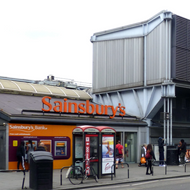Sainsbury's Christmas Performance: A Mixed Bag of Festive Feasts and Retail Challenges
Posted by Emily on 11th Jan 2024 Reading Time:
During the festive period, Sainsbury's, Britain's second-largest supermarket chain, experienced a surge in grocery sales while facing downturns in its general merchandise and clothing sectors.
 Philafrenzy, CC BY-SA 4.0, via Wikimedia Commons
Philafrenzy, CC BY-SA 4.0, via Wikimedia Commons
Grocery Sales: A Festive Triumph
Sainsbury's reported a 7.4% increase in overall sales during the 16 weeks leading up to January 6. This growth was primarily driven by a significant 9.3% rise in grocery sales. The supermarket chain attributes this success to its effective market share capture from competitors, underpinned by popular products like pigs in blankets, mince pies, and sparkling wine.
The festive period saw grocery sales up by 8.6% over six weeks, a testament to Sainsbury's strategy of focusing on food retail. This performance was bolstered by strong sales in the 'Taste the Difference' premium range and the effective use of artificial intelligence in stock management.
Challenges in General Merchandise and Clothing
However, this robust performance in groceries was contrasted by weaker results in other areas. General merchandise, including Argos, saw a 0.6% decline, while clothing sales dropped by 1.7%. Factors contributing to these struggles included unseasonable weather and a competitive promotional market. Despite these challenges, the exclusion of Argos store closures in the Republic of Ireland showed a 1.5% increase in general merchandise sales.
Market Position and Strategies
Under CEO Simon Roberts, Sainsbury's has concentrated on its food business, closing unprofitable Argos stores and investing in price competitiveness. Strategies like the Aldi price-match programme and Nectar prices have reshaped customer perceptions of Sainsbury's pricing, contributing to its market share growth to 15.8% as of last month, with Tesco leading at 27.6%.
Financial Outlook and Controversies
Sainsbury's performance in groceries and efforts in pricing has led to a strong market position despite criticisms from consumer groups like Which? Regarding the transparency of savings in loyalty card schemes. The company maintains its commitment to clear pricing policies.
The supermarket expects an underlying annual pre-tax profit between £670 million to £700 million, maintaining guidance from November. This forecast and a strategy update planned for next month indicate a continued focus on reinforcing its food-centric approach.
Retail Landscape: A Broader Perspective
The broader retail sector saw varied performances, with discounters like Aldi and Lidl reporting festive solid trading. In contrast, others like JD Sports Fashion faced challenges. The industry reflects a complex interplay of consumer behaviour, cost of living pressures, and retail strategies.
In conclusion, Sainsbury's festive season has showcased its strengths in grocery sales while highlighting the challenges in other retail sectors. The company's focus on food retail and pricing strategies has positioned it well in a competitive market, with an eye on sustaining growth amidst changing consumer preferences and economic conditions.

